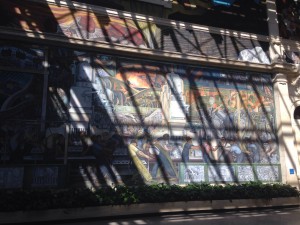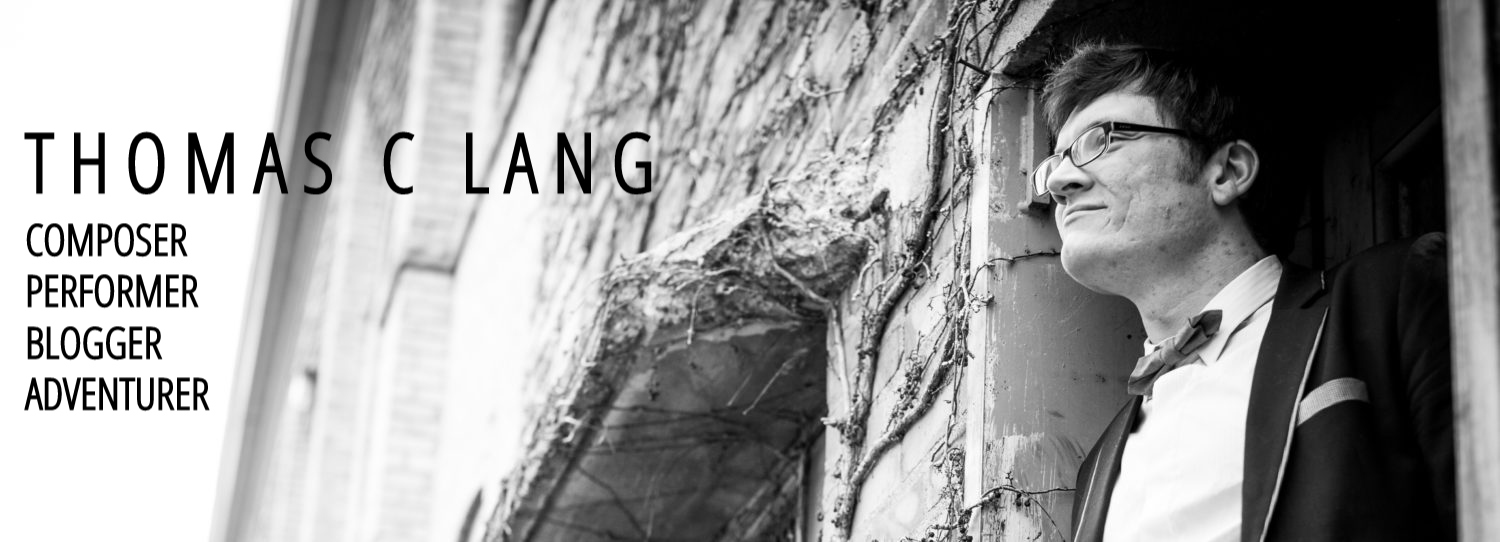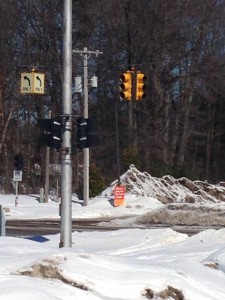
It’s 7 March 2014…
I mentioned yesterday while writing about my experiences in Michigan in Interlochen and Lansing that not only is there a quaintness about the state, there is also a grittiness about the state. Lots of my third day of this trip was spent in Detroit, and Detroit is certainly grittiness incarnate.
Perhaps out of naivety, I didn’t want to believe a city that was such a proud symbol of human innovation could have fallen to such a painful and necessary reminder of what happens when we choose not to invest in our own best interests. How we spend our money is a direct confirmation of whether the values we say we believe in are actually the values we live. We’re all guilty (and don’t deny it) of allowing our actions reveal the hollowness of some of our words.
Even despite all the terrible things people say about the city (and despite some of the terrible things I’ll say about the city), I still highly recommend a visit. It is a sad and dangerous and crumbling city, but it is also a vibrant city, a colorful city, and a city worth our attention.
 On the drive into Detroit on Woodward from White Lake, I eventually came across the various “certain mile” roads. The certain mile most infamous is 8 (as in 8 Mile Road), and the road still continues to remain a major marker for the racial divides that persist in the area. The movie 8 Mile will now have a somewhat more resonant meaning than previously.
On the drive into Detroit on Woodward from White Lake, I eventually came across the various “certain mile” roads. The certain mile most infamous is 8 (as in 8 Mile Road), and the road still continues to remain a major marker for the racial divides that persist in the area. The movie 8 Mile will now have a somewhat more resonant meaning than previously.
As I drove farther and farther into the city, I uncontrollably became more and more uncomfortable and felt more and more unsafe. This is true. This is a part of the world that I never knew before. A part of the world that went wrong. Right inside our country’s borders, even though Canada’s quaint city of Windsor is right across the way, here is a place that makes me feel more unsafe than I’ve ever felt before. So, I retreated into something that was familiar: the museum. Specifically, the Detroit Institute of Art.
 A fantastic collection, to be sure. There was a a Japanese samurai exhibit at the time, and I admired the delicate work of ink on canvas, scrolls, ceremonial armor, and screens. Subtly colorful cranes, painstakingly crafted swords, delicate ceramics for solemn tea ceremonies.
A fantastic collection, to be sure. There was a a Japanese samurai exhibit at the time, and I admired the delicate work of ink on canvas, scrolls, ceremonial armor, and screens. Subtly colorful cranes, painstakingly crafted swords, delicate ceramics for solemn tea ceremonies.
I also took time to admire the van Goghs, Picassos, Mattisses, and Warhols. And, naturally, the Detroit Industry Murals by Diego Rivera. I’ve seen photos of the work, but to see it in person was a wonderful experience. A celebration of what created Detroit. A colorful celebration. A vibrant celebration. A celebration through a lens. A celebration seen through someone else’s eyes. Workers working hard, toiling away at machines. Goddess-like individuals, reclining, staring down into where the real works happens.
The workers working… were they happy? Sad? Complacent? Proud? Angry? Were they celebrating serving the machine? Were they there by choice? Did they have somewhere else to go? Or was this their lot?
The workers in the mural were a nice reminder that it was time to venture out into real Detroit to see the city through my lens and not someone else’s, as illuminating, helpful, and necessary as that can be.
 After a quick lunch of Coney dogs (I highly recommend American Coney Island and Lafayette Coney Island, both right next to each other on Lafayette in downtown), I made a trip to the old Michigan Central Station. Ever since Huffington Post wrote an article on the haunting images of Detroit’s crumbling infrastructure, I became fascinated. Michigan Central Station epitomizes Detroit’s sad story, and it’s in an area of town where I felt moderately safe (but, do keep your guard up, and don’t stand idle taking pictures too long).
After a quick lunch of Coney dogs (I highly recommend American Coney Island and Lafayette Coney Island, both right next to each other on Lafayette in downtown), I made a trip to the old Michigan Central Station. Ever since Huffington Post wrote an article on the haunting images of Detroit’s crumbling infrastructure, I became fascinated. Michigan Central Station epitomizes Detroit’s sad story, and it’s in an area of town where I felt moderately safe (but, do keep your guard up, and don’t stand idle taking pictures too long).
As I observed the structure and took my pictures, I couldn’t help but remember the workers in the Rivera murals. Were the people who built the station like the people in the murals? Did they build it happily? How much did they get paid? Did they have other options for work? Did they feel a sense of pride when they finished the building? What would they think of it now, seeing it in severe disuse and fraying at the seams, surrounded by fences and barbed wire as if the whole site became stuck in a nightmare out of the Great War?
So, what to do next? What can we do with these old buildings that once stood as proud monuments to human achievement? Well, I do what I do best: retreat back into art. So, it’s time for a different kind of art. Not the kind in smooth, polished buildings of marble, the kind of art for certain people, the kind of art that you have to pay to be able to see. But rather a kind of art for the people and by the people.
 It’s a curious street, Heidelburg. Out of the ashes springs something new and different. One house on Heidelburg literally did breathe new life out of new ashes, having been a victim in a string of senseless arson attacks on the street, but having been re-envisioned with a new installation of art. Out of the rubble came new, truthful beauty. The image to the right is not of the most recent arson attack, but it does display a house that someone did burn to the ground and that the artist re-purposed into a new vision.
It’s a curious street, Heidelburg. Out of the ashes springs something new and different. One house on Heidelburg literally did breathe new life out of new ashes, having been a victim in a string of senseless arson attacks on the street, but having been re-envisioned with a new installation of art. Out of the rubble came new, truthful beauty. The image to the right is not of the most recent arson attack, but it does display a house that someone did burn to the ground and that the artist re-purposed into a new vision.
While I still absolutely admire the art in the DIA, I absolutely adore the work of Tyree Guyton’s Heidelburg Project. The murals of the workers in the DIA are one lens of truth, but I couldn’t help but feel that Rivera’s lens cheated truth a bit, as much as what he painted must have been the truth as he saw it. The art of the Heidelburg street, however, captures the grittiness of Detroit, unapologetic about the truth of what the city is and what the city was; celebrates the vibrant good of humanity, a crystal mirror about what the people of Detroit are and what the people of Detroit were; and painfully reminds us of certain inherent evils within humanity, uncensored about what actions we take and what actions we have taken.
As I drove out of Detroit, as I passed by 7 mile and 8 mile and onwards, as I passed by cinders upon cinders of houses, as I passed by the horrors and beauty to see, as I passed by a city of truth, a city that reveals that humans can create good and evil in very short amounts of time, as I passed by all this, I remembered that we have an awful lot of work to do. But, these are just my words, and my actions reveal the hollowness of these words. I wrote a blog post about this, to be sure. Someone might read this, of course. And someone else might become inspired to take action. But what else can we do? What sum of money can save a city of such decay? $850,000,000? What actions are required? What can we do?
I just don’t know. But I do implore you to visit this city. It is a beautiful, sad city. It is a city that tells the truth as it is. It is a city that provides windows into another world, and it is a city that displays mirrors into our own selves. No lenses except yours.
But do be careful. Watch your back.
But do open your eyes. Watch your lens.













